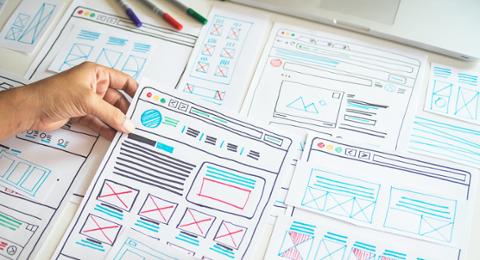
User experience (UX) designers are responsible for how users interact with a company’s apps, services, and other products. In addition to requiring expertise in a variety of design platforms, UX designers must also be outstanding communicators with a keen sense of empathy and attention to detail.
Stewart Pressney, enterprise design team lead at Toptal, thinks a solid set of technical abilities, whether rapid prototyping or some exposure to coding, is very helpful for anyone who wants to build a successful UX career. “You don't necessarily have to be a developer, but it's good to understand how things work,” he says. “Add to that being able to use typical design tools like Figma and Adobe Photoshop Illustrator and some animation tools like After Effects.”
What's even more critical is an understanding of how to utilize thinking tools and user research methods to articulate why design decisions are being made. “Those could be things like SWOT (Strengths, Weaknesses, Opportunities, and Threats) analysis or journey maps, empathy maps, or even surveys and interviews, talking to people and figuring out what they would like out of a product and how certain products aren't working at the moment,” Presssney adds.
UX designers must craft a portfolio that shows how they think through problems—something that many miss when deciding which work to show off. “Oftentimes you'll see really high-fidelity mockups of the end state of a product,” Presssney says. “But hiring managers really want to see how you got from A to B and how certain decisions were made to achieve certain goals within a business.”
Data Fluency and Learning Data Tools
Jon Halk, senior director of design and product for TextNow, says he’s been emphasizing the concept of data fluency (both on the qualitative and quantitative side) with his team. “The qualitative side [encompasses] an understanding of methodologies and basics of research, while on the quantitative side, it's really understanding how to look at data or even the types of data that you would want to look at as that relates to user behavior," he says.
Halk says it's critical for UX designers to be data-fluent and have a deep understanding of how to quantify the impact of designs—as well as communicate data effectively to whoever’s viewing the final product. “Everyone can have their own opinions but not their own facts,” he says. “One thing I highly stress to designers is understand the basics of how to look at data. There's plenty of tools out there to help understand if your design is performing well or solving a problem.”
There is an increased expectation today for UX designers to think more from a business or product standpoint, he adds: “Now it's more of an end-to-end user experience… That can include thinking about the product when it's not being used and thinking about the gaps in the user journey.”
Because design has become “a lot more important,” UX designers must be able to strengthen partnerships between product management, engineering and product designers. There is a lot of overlap between roles.
Pressney, who received an interaction design degree at a fine arts university, thinks successful UX designers can start with an academic background in psychology or liberal arts. “Through either a bootcamp program or online courses, pick up the hard skills we're looking for, whether that's using Figment or Prototype or After Effects for animations or making components in Webflow that developers can take and put into their products,” he says. “There's also a lot of resources on YouTube, as well, which is a great wealth of knowledge and it's all free.”
Communications and Leadership Skills are Key
Halk says communications and leadership skills are at the top of the list of any effective UX designer, as they must ensure everyone understands the purpose of the project—and align all stakeholders to that purpose.
“You have to lead your team by showing up within the organization as the evangelist for your team and empower them to create some tension—healthy tension-- across the different departments, be it technology or business,” he says. “Make sure you create that environment for the team to have a seat at the table and create the conditions for success.”
This includes making sure everyone is clear on the problems that you're looking to solve and providing a healthy environment in which to solve them. “There's the need to be able to throw ideas out there, and in order to have the best ideas and the time to do it, you're always dealing with the spectrum of innovation and replicability,” he says. “If you don't have enough time, you're just going to fall back on what you know. You need time to really innovate, to really be able to work on something, take a step back and realize it's not the right direction and go in a different direction.”
Building Skill Sets Over Time
Pressney considers rapid prototyping a strength, especially when it comes to quickly building things off an idea. “My progression has been through becoming a bit of a developer, going through a coding bootcamp, learning 3D tools, and then more recently learning how to how to lead a team and interact with peers and work with design operations,” he says.
He admits it can be overwhelming to look at a senior designer within an organization and wonder how they learned all these skill-sets and how they arrived in that position. “When you're just breaking into the industry, I think it's good to specialize in a key area where you're adding a lot of value to the sort of team that you want to work on,” he says. “Whether that's a technical or creative team, that will help you get that first job and then you can start adding to your skill set as you improve.”
UX designers must be a bridge between multiple teams. “Usually that's marketing and the creative department, as well as engineering and the developers actually building products, and leadership or administration,” Pressney says. “It's important to have skills in tools like empathy maps and journey maps.”
It’s always helpful to create a document (or similar asset) that allows multiple stakeholders to see not only the current state of a product, but also its potential future and how it may impact customers. “If you have a very clear, well-designed document that has research backing, showing what any given product is doing in a certain space, it really helps to align teams around their goals,” he adds. “I always say that the foundation of a good UX designer is being able to actually talk to users and figure out how they're reacting to products.”
Related UX Designer Jobs Resources:


